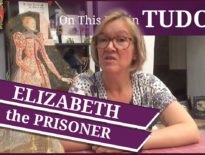On this day in Tudor history, 24th May 1546, letters were sent from the Privy Council to the future Protestant martyr Anne Askew and her estranged husband Thomas Kyme.
The couple were ordered to appear in front of the council within fourteen days. But why? What was going on? And what happened next.
In today's talk, I give an overview of the life of Anne Askew, who was famously racked illegally at the Tower of London prior to being burnt as a heretic.
Also on this day in Tudor history, 24th May 1562, according to contemporary sources, a "monstrous" child was born in Chichester, Sussex.
This deformed baby was not the only "monstrous" birth that year and these events were seen as signs from God. Find out more in last year’s video:
More Anne Askew videos:
Also on this day in history:
- 1522 – Birth of John Jewel, Bishop of Salisbury and Apologist of the Church of England, in Berrynarbor, North Devon.
- 1576 – Birth of Elizabeth Chamberlain, Lady Chamberlain, daughter of Sir George Carey, 2nd Baron Hunsdon (grandson of Mary Boleyn), and Elizabeth Spencer. Elizabeth I was Elizabeth's godmother.
- 1612 – Death of Robert Cecil, 1st Earl of Salisbury, politician, courtier and Elizabeth I's Secretary of State, at Marlborough, Wiltshire. Cecil was the only surviving son of William Cecil, 1st Baron Burghley.
- 1616 – Death of Margaret Clifford, Countess of Cumberland, at Brougham Castle, Westmorland. She was buried in Appleby Church.
Transcript:
24 May
On this day in Tudor history 24th May 1546, letters were sent from the Privy Council to the future Protestant martyr Anne Askew and her estranged husband Thomas Kyme. The couple were ordered to appear in front of the council within fourteen days.
But why? What was going on?
Let me tell you about Anne Askew, and this is based on an article I did for the Anne Boleyn Files a few years ago.
Twenty-five ear-old Anne Askew was from Stallingborough in Lincolnshire and was the daughter of landowner Sir William Askew and his first wife, Elizabeth Wrottesley. She received an excellent education and Karen Lindsey, author of “Divorced, Beheaded, Survived: A Feminist Reinterpretation of the Wives of Henry VIII”, writes of how Anne was influenced by the Protestant ideas that her brothers, who were students at Cambridge, would discuss when they came home to visit, but that the Askew family were conservatives and Anne’s father opposed the rebels during the Pilgrimage of Grace in 1537. It was the Pilgrimage of Grace that Lindsey gives as a reason for Anne turning her back on the old faith, because Anne saw the rebels attack her home and seize her brothers.
At around this time, Anne was forced to marry Thomas Kyme. Kyme had originally been betrothed to Anne’s older sister Martha but when she died, Anne was offered as a replacement. It was not a happy union, but it did result in two children. Kyme was traditional in his religious views and Anne, by this time, had strong Protestant views. Lindsey believes that Anne probably survived the early days of her marriage by spending her time with her sister Jane, who was married to a Protestant, George Saint Paul. Saint Paul was friends with Charles Brandon, Duke of Suffolk, and his wife Catherine (née Willoughby) who was a supporter of religious reform. From 1538-1543 the law allowed normal parishioners access to the English Bible in churches and those of Protestant leanings took the opportunity to conduct Bible readings and share their evangelical views, Anne was one of those people.
In 1543, King Henry VIII changed his mind about Bible reading, and passed an act which prevented all women (and men below the rank of gentlemen) from reading the Bible. This did not prevent people like Anne from sharing their views and preaching, because they had memorised scripture. In fact, this law made Anne even more determined to share her Bible knowledge with those who were deprived from reading the Bible themselves. Kyme, a traditional conservative, could not and would not cope with his outspoken wife, a woman who even refused to take his name, so, as advised by his local priests, he kicked her out of the family home. Anne simply moved in with her brother Francis and petitioned for divorce. Her petition was denied by her local court so Anne headed to London where she was convinced that she would get her divorce. As Lindsey writes:
“Like the king’s new wife [Catherine Parr], Anne revered Henry for freeing his people from the evil of popery. She was certain the king, who had himself disposed of several unworthy spouses, would allow a godly woman to be free of her unbelieving husband.”
While in London, Anne met up with an old friend and neighbour, John Lascelles, a man of Protestant persuasion, and it was he who introduced her to people like Hugh Latimer, Bishop of Worcester; Nicholas Shaxton, Bishop of Salisbury, and Dr Edward Crome. These men were not only high profile Protestants, they were also connected to Henry’s new queen, Catherine Parr. Anne flourished with the support of such friends and the climate of reform in London.
Unfortunately, although some of London was open to reform and fell in love with this passionate woman, Anne was making enemies. Bishop Stephen Gardiner, a Catholic Conservative, was looking to discredit the new queen, Catherine Parr, and deal with Protestant climate that seemed to surround her. Anne Askew was not only an outspoken heretic stirring up the people of London, she was also linked to the Duchess of Suffolk, who was a good friend of the Queen. Perhaps Anne could be used to bring down the Queen.
In June 1545, Anne Askew, and a few other Protestant sympathisers, were rounded up and arrested for heresy, but later released due to lack of evidence and witnesses. A few months later, in early 1546, Anne’s petition for divorce was dismissed and the court ordered her to return to Kyme, something which Anne refused to do. Gardiner was keen to use this refusal against her. Although she had been arrested again in March 1546 and subsequently released, Gardiner summoned her to London to order her to return to her husband and he used this opportunity to question Anne on her religious beliefs. Anne shared her religious views, including her denial that Christ was present in the sacrament, saying that the bread was just bread and that if it was left for 3 months then it would go mouldy. She stated that she believed that “the sacramental bread was left us to be received with thanksgiving, in remembrance of Christ’s death, the only remedy of our soul’s recovery”. This was heresy and she was tried for it at Guildhall on 18th June 1546, found guilty and condemned to death.
After being condemned to death, Anne Askew was taken to the Tower of London, where she was subjected to torture on the rack at the hands of Gardiner’s right-hand men, Sir Richard Rich and Sir Thomas Wriothesley. Even though she had already been condemned to death, she was racked because Gardiner was determined to link Anne to the Queen’s friends, women like the Duchess of Suffolk, the Countess of Sussex and the Countess of Hertford, and Anne was refusing to name names during her interrogations.
As Anne had already been condemned and she was a gentlewoman, the Lieutenant of the Tower, Sir Anthony Kingston, refused to continue racking Anne after the first turn. He left the Tower in search of Henry VIII to inform him of this illegal and appalling torture, and to seek a pardon for letting it happen. This did not stop Rich and Wriothesley, they simply racked the poor woman themselves until they were stopped by Kingston, who informed them that the King had ordered that Anne should be taken off the rack and returned to her prison cell.
Anne was so badly racked that on 16th July 1546 she had to be carried to the stake on a chair and the stake on which she burnt for heresy had to have a seat attached to support her body. Awful.
What happened to Thomas Kyme her husband? Well, he did turn up in front of the Privy Council with Anne within the stipulated 14-day period. Anne denied that he was her husband and while she was detained and thrown into the Tower of London to await her trial, he was allowed to go home.



This is fascinating and horrifying. John Gardener was my 14 times great grandfather. How closely we are all linked to horrible events!
I am proud to be a decendent of Anne! She stood strong on Biblical principles of Christ. She was 100%, correct in her summation, and biblical understanding, of Christ’s Word, and the twisted catholic church teaching! Anne will reap her rewards in the very presence of Christ Jesus Himself, at the final judgment!